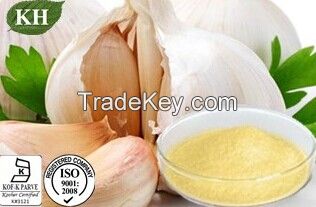Description
Garlic Extract
Botanical Source: Allium Sativum L.
Part Used: Bulb,**0% Natural
CAS No.: *******6
Specification: Allicin 0.6%, 0.8%,1%, 2%
Ratio Extract: *0:1,**0:1
Appearance: Fine light yewllo powder
Molecular Formula: C6H*0OS2.
Molecular Weight: **2.*8.
Description:
Garlic is an herb. It is best known as a flavoring for food. But
over the years, garlic has been used as a medicine to prevent or
treat a wide range of diseases and conditions. The fresh clove or
supplements made from the clove are used for medicine. Garlic is
used for many conditions related to the heart and blood system.
These conditions include high blood pressure, high cholesterol,
coronary heart disease, heart attack. Garlic actually may be
effective in slowing the development of atherosclerosis and seems
to be able to modestly reduce blood pressure. Some people use
garlic to prevent colon cancer, rectal cancer, stomach cancer,
breast cancer, prostate cancer, and lung cancer. It is also used to
treat prostate cancer and bladder cancer.
Garlic has been tried for treating an enlarged prostate (benign
prostatic hyperplasia; BPH), diabetes, osteoarthritis, hayfever
(allergic rhinitis), traveler's diarrhea, high blood pressure late
in pregnancy (pre-eclampsia), cold and flu. It is also used for
building the immune system, preventing tick bites, and preventing
and treating bacterial and fungal infections.
Other uses include treatment of fever, coughs, headache, stomach
ache, sinus congestion, gout, rheumatism, hemorrhoids, asthma,
bronchitis, shortness of breath, low blood pressure, low blood
sugar, high blood sugar, and snakebites. It is also used for
fighting stress and fatigue, and maintaining healthy liver
function.
Some people apply garlic oil to their skin to treat fungal
infections, warts, and corns. There is some evidence supporting the
topical use of garlic for fungal infections like ringworm, jock
itch, and athlete’s foot; but the effectiveness of garlic against
warts and corns is still uncertain.
There is a lot of variation among garlic products sold for
medicinal purposes. The amount of allicin, the active ingredient
and the source of garlic’s distinctive odor, depends on the method
of preparation. Allicin is unstable, and changes into a different
chemical rather quickly. Methods that involve crushing the fresh
clove release more allicin. Some products have a coating (enteric
coating) to protect them against attack by stomach acids.
While garlic is a common flavoring in food, some scientists have
suggested that it might have a role as a food additive to prevent
food poisoning. There is some evidence that fresh garlic, but not
aged garlic, can kill certain bacteria such as E.coli,
antibiotic-resistant Staphylococcus aureus, and Salmonella
enteritidis in the laboratory.
How does it work?
Garlic produces a chemical called allicin. This is what seems to
make garlic work for certain conditions. Allicin also makes garlic
smell. Some products are made “odorless” by aging the garlic, but
this process can also make the garlic less effective. It’s a good
idea to look for supplements that are coated (enteric coating) so
they will dissolve in the intestine and not in the stomach.
Functions:
Anti-bacteria; Antifungal; Antiviral:
Allicin has a strong exterminate action on gram-positive bacteria
and gram-negative bacteria,
can effectively inhibit fish, livestock and other poultry
diseases;
Lower your Cholesterol Level;
Enhance immunity, and promote the healthy growth of livestock and
poultry fish;
Prevention of atherosclerosis, protect the heart against
attack;
Have antipyretic function, detoxification, promoting blood
circulation to remove blood stasis;
Fall hematic fat, fall blood pressure, fall blood sugar and
anti-platelet aggregation;
Improve plasminogen activity, to restrain and kill tumor cells,
prevention and treatment of tumor;
It can reduce the coronary atherosclerotic plaque, can resist blood
tied;
Allicin can effectively stimulate the animals produce aroma
formation of amino acids, increase the aroma components of meat and
eggs C3H5S (O) gene, the freshness of meat and eggs;
